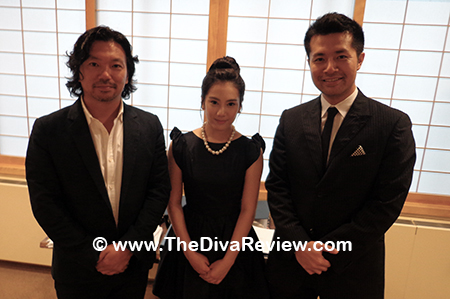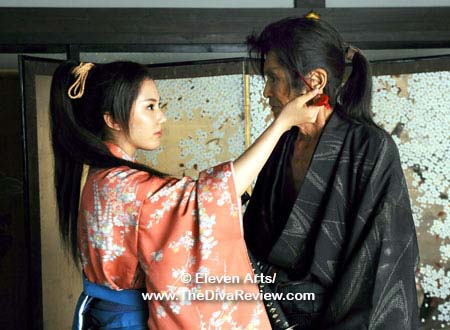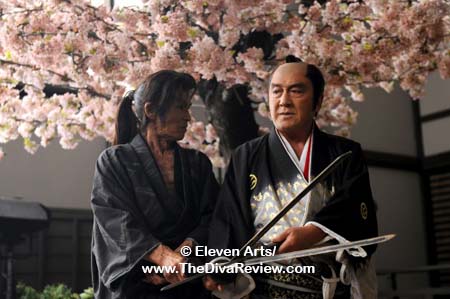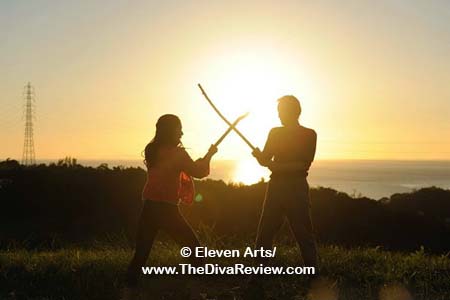
Hey, boys and girls, as cineastes fret over the future of the samurai movie, Uzumasa Limelight is a love letter to the unsung heroes of samurai cinema, the kirare-yaku; the team of actors whose job is to die spectacularly on screen, as seen through the fictional eyes of one of its true artists. We had a chat with the director, star and producer at the Japan Cuts festival.
Dig it!
Uzumasa Limelight
Director Ken Ochiai, Actress Chihiro Yamamoto & Producer Ko Mori

The Lady Miz Diva: Youíve written your previous features and short films, but this film came from somewhere else. Please tell us how Uzumasa Limelight came to you?
Ken Ochiai: Well, first of all, there was Seizo Fukumoto {Laughs}, the legend. This story and the script was largely based on his life. Hiroyuki Ono, the writer/producer, has kind of been with him through filming and also he lives in Kyoto, so he got to know Fukumoto-san and he got fascinated by the story, so he started writing the script. It took some time for him to actually launch the project, because you know, itís about a movie extra, so it was really hard to find funding, but it landed onto the producer, Ko Mori, who lives in LA, and he was interested in the project and also fascinated by Fukumoto-san. I knew Ko Mori from my short films and I lived in LA, and weíd met several times before; so about two years ago, he talked to me about this project. I read the script and the proposal and I started doing research about Fukumoto-san and read his books. I just fell in love with him and I told Ko that I really wanted to do this project and I wanted to meet Fukumoto-san in person.
So I went to Kyoto to see him; not to greet him as a director, but to just say hello to him. And he has this class to teach how to do choreography for samurai swords, so I took one of the classes and he taught me in person how to do choreography step-by-step. Itís different from kendo, the Japanese sword fighting. Itís really unique in that itís specialised to make movies, so it was just slightly different. But he was a great teacher and also I got to know him more and I fell in love even more. So I talked to Hiroyuki Ono and Ko Mori and we developed the script even more. So although I didnít write the script, I felt like this is a really personal film to me.
 LMD:
How much of the film is based on Fukumoto-sanís life?
LMD:
How much of the film is based on Fukumoto-sanís life?
KO: Thatís a very fine line. Once you know him, he is not like the guy who is silent or grumpy {like the character in the film}, heís more talkative, and also he loves to take care of the younger generation. Itís a little different in that way; heís got a wife and kids - heís not alone. So I would say 50 - 60% is based on his real life, especially the fact that heís been killed 50,000 times in movies. If you do the math, itís like almost 3 times a day.
 LMD:
I love that the film opens up with the Limelight quote by Charlie
Chaplin. When did the inspiration to meld the story of the kirare-yaku
and Fukumoto-sanís life with Limelight come in?
LMD:
I love that the film opens up with the Limelight quote by Charlie
Chaplin. When did the inspiration to meld the story of the kirare-yaku
and Fukumoto-sanís life with Limelight come in?
KO: The writer/producer, Hiroyuki Ono, is also the president of the Chaplin Society of Japan. I mean, I love Chaplin, but heís got a PhD on Chaplinís films, so he pretty much knows everything about Chaplin, and he wanted to combine Limelight into Uzumasa Limelight. I hope it comes off more as an homage, not like stealing or anything, itís not.
LMD: Was Fukumoto-san, who is such a repository of chambara knowledge and experience, helpful to you with regard to staging the swordfighting scenes, or insight to what life was really like behind the scenes of the samurai dramas?
KO: Well, heís such a humble person, especially when it comes down to acting. He doesnít think heís an actor; he thinks heís kirare-yaku. He doesnít think heís a lead actor. One of the most difficult things for this movie was to convince him to play a lead role, because he so humble, he was like, ďThat would be impossible, I canít do lead acting. Get somebody younger and Iíll support that person.Ē Well, he finally gave us an okay because this film would be a catalyst to the younger generation to get an interest in jidaigeki movies. One of the funny stories of Fukumoto-san, is because heís so humble and because heís been supporting the lead actor for 55 years, if I point the camera {at him}, he would always stay on the side of the frame. ďFukumoto-san, you should be in the middle.Ē ďOh, no, no. This is impossible!Ē {Laughs}
 LMD:
Iím curious about the kirare-yaku. The men in your film seem happy to
stay in the background, never looking to be the star. Is that what you
found? What would you say if their mindset?
LMD:
Iím curious about the kirare-yaku. The men in your film seem happy to
stay in the background, never looking to be the star. Is that what you
found? What would you say if their mindset?
KO: Yeah, I think most of them wanted to be lead actors first; they just wanted to practice by being in a supporting role. Fukumoto-san is a little different from those actors, because there are a lot of lead actors who started as kirare-yaku, but became someone famous. But Fukumoto-san has always liked being in the supporting role. He wanted to perfect his craft of being killed, so itís a little different mindset in that way. But I guess for this movie, everyone was supporting Fukumoto-san, because he has been supporting everyone else. So it was like a great payback.
Even the lead actor, he has been hundreds of movies, Hiroki Matsukata, he plays a supporting role, which is unusual for someone like Fukumoto-san, who is just being killed in movies. But the brotherhood between Matsukata-san and Fukumoto-san is something really touching because theyíve been acting together since they were like 16 or 17, so they have 50 years. Fukumoto-san called him older brother in Japanese, and then Matsukata-san called him ďFuku-bonĒ as kind of like a nickname. Itís so lovely to see them; they are like 70-year-old best friends, and on set they have this trust between them. In terms of choreography, you really have to be in sync with everyone, but especially Fukumoto-san and Matsukata-san are completely in sync. Itís pretty incredible.
LMD: I felt sometimes like I was watching two films because you have the drama of this manís story, and the end of this way of life; then you have the actual fighting scenes, which are so enjoyable. Did you sometimes feel like you were directing two different films? Did you approach those aspects differently?
KO: I wouldnít say completely differently. I mean, in terms of choreography, I had about three different types of choreography: The opening sequence was more like Hollywood style; everything was shot in green screen. Thatís what I wanted to do and a lot of people actually love that first sequence, it was so different from normal samurai movies that are shot in Japan, so people loved it. Then there was the TV kind of samurai choreography in the middle of the movie, where Matsukoda-sanís the lead. Then the last one is kind of like movie-style; itís really a mix of traditional choreography and also Hollywood-style choreography, so was like a marriage between those. But in the movie, thereís a line, ďIf you can do action, you can act.Ē I didnít think there was any difference in action, I thought it was performance.
 LMD:
Regarding the action scenes, Fukumoto-san is really amazing to watch,
heís so quick and agile. However, he is 72 years old. Were you quite
careful about staging his fight sequences? I felt concerned every time
he did that fall.
LMD:
Regarding the action scenes, Fukumoto-san is really amazing to watch,
heís so quick and agile. However, he is 72 years old. Were you quite
careful about staging his fight sequences? I felt concerned every time
he did that fall.
KO: Yes, I guess everyone else was worried. Heís older, obviously, as you said, but he practices his craft every single day, and heís the one kind of pushing the envelope. I would be asking, ďWould it be okay to do one more take?Ē And then heís like, ďNo problem, Iíll do as many takes as you want.Ē And everyone else was like, ďBe careful.Ē {Laughs} We were a bit aware of his vulnerability, as well, so we definitely thought about how to minimise. Also, we didnít have as many days as we wanted, so in this limited condition, we wanted to be as efficient as possible. We shot for a total of 17 days.
LMD: More than just the story about this fading part of the industry, I felt thereís an important statement about the treatment of elders in the current culture. To us in the west, Japan is all about respect for the elders; but hereís a man who is still obviously fit and knows more about movies than a whole film school, yet heís dismissed because of his age. Was looking at the treatment of the elderly any part of your thought while making the film?
KO: Yes. I mean, in a way this film is all about generations and how thereís a gap between them, and also passing on the skills to the next generation. So in that way, we were thinking of generations and how less and less people are doing that craft of kirare-yaku. Back in the day, the studios had about 100 to 150 actors in the 1940s in the 50s, but Fukumoto-san was actually one of the last ones. In 1965, he retired from the studios and became freelance, so we donít have those actors anymore. We wanted to have that familiarity of those actors on set, as well, and that everyone wanted to support him. He is the president of Tsurugi-kai, which is a group of specialists for that kind of samurai choreography in Toei.
 LMD:
Can you please talk about finding Ms. Yamamoto, who had not worked in
films before?
LMD:
Can you please talk about finding Ms. Yamamoto, who had not worked in
films before?
KO: She is the world champion of Chinese martial arts and sheís quite well known, and I guess one of the casting directors shared the information about her. We brought her to the audition and we did a little bit of reading of the script and little bit of choreography in the gym, and she was amazing. {Laughs} As soon as she holds the sword - and it was her first time holding an actual wooden sword for Japanese-style, because she learned Chinese style - and she was perfect.
LMD: That scene where Satsuki does bad take after bad take is painful to watch. Did you relate to her nerves?
Chihiro Yamamoto: Yes. I always wanted to do the scenes in one take, but I made a couple of mistakes and sometimes it became four and five. But Fukumoto-san and the other actors were always finished in one, so I always wished that I could do better.
LMD: Were the veteran actors like Fukumoto-san helpful to you?
CY: Yes. Having 55 years being in the kirare-yaku, he knows everything about ďkiruĒ - which is ďto cutĒ - and how to cut in a cool way. Because he has seen and worked with all the stars, he taught me how to cut, as well.
LMD: Was the action or the drama the most challenging aspect of this role for you?
CY: I enjoyed the action sequences, because I loved the action part. I even felt relaxed doing the action. But on the other hand, during the acting part, I kind of felt nervous because I hadnít done anything like that before, anything big like this.
LMD: As you working with a new actor, did you as the director suggest any research that Ms. Yamamoto should do, perhaps like view the original Limelight in preparation for this role?
KO: Yes, we did. We talked about Limelight as kind of a baseline for this movie. And Claire Bloom is obviously one of the best actresses, but then she was no one when she was shooting Limelight.
 LMD:
Your history and education is interesting to me. Having studied and
made films here in the US, have you found yourself at odds when you work
in Japan with a Japanese crew?
LMD:
Your history and education is interesting to me. Having studied and
made films here in the US, have you found yourself at odds when you work
in Japan with a Japanese crew?
KO: Yes, it is always like that. In a sense, Kyoto is where Japanese films started, so they have the traditional filmmaking, which is completely different from the Hollywood way of filmmaking. So, there was a little bit of conflict between that; the Kyoto crew and me, but in a good way, because weíre all trying to make a good movie and we talked to make it better. So the difference actually worked for us.
The thing is, I grew up in Japan, and also I learned filmmaking in LA, so every time I go back, I kind of felt that Iím not really Japanese and that people donít really treat me as a Japanese, but here, they donít treat me as an American - obviously, Iím Japanese. There is a sense of loss of identity; where do I belong? Whereís my home? So, that kind of theme always comes into my movies, especially this one in a way that Seizo Fukumoto {as Kamiyama} is kind of at a loss; that when he lost his job, he didnít feel like he belongs anywhere. He feels like he belongs to the movie set.
LMD: Your cinematographer is Chris Freilich, who one might not associate with a modern samurai film made in Japan.
KO: Well, he did Tiger Mask with me. We went to AFI together. Weíve been making movies together and it was Koís advice to bring Chris on board as well to have the American way of filmmaking in traditional Kyoto.
 LMD:
What would each of you like for Uzumasa Limelight to say to audiences?
LMD:
What would each of you like for Uzumasa Limelight to say to audiences?
CY: I felt like the younger generation, including myself, does not know about jidaigeki - the samurai movies - and how good a film genre it is. I feel I would like this movie to be a catalyst to spark an interest for the younger generation.
Ko Mori: Not only is there a certain culture, as the movie says, in Uzumasa and Uzumasaís way of filmmaking, but thereís definitely something to learn, generally speaking, from this movie. Especially the way Fukumoto-san is in the role and also Chihiro, and that relationship, and the way they are; definitely we would like to deliver a certain message to the audience from that.
KO: Well, two things: One, the theme of the movie, I believe is universal. He got killed 50,000 times, but that means he got up 50,000 times. No matter how many times you get beat, you come back up and you keep doing that. And also, the other thing is passing on your skills to the next generation. One of the things that Fukumoto-san is doing in this movie to Chihiro - as Kamiyama did to Satsuki - this movie can pass on the kind of interest and also the tradition and skills that people in Kyoto have been developing with the rest of the world. So I hope we can share that with everyone.
~ The Lady Miz Diva
July 19th, 2014
© 2006-2022 The Diva Review.com
|
|
















